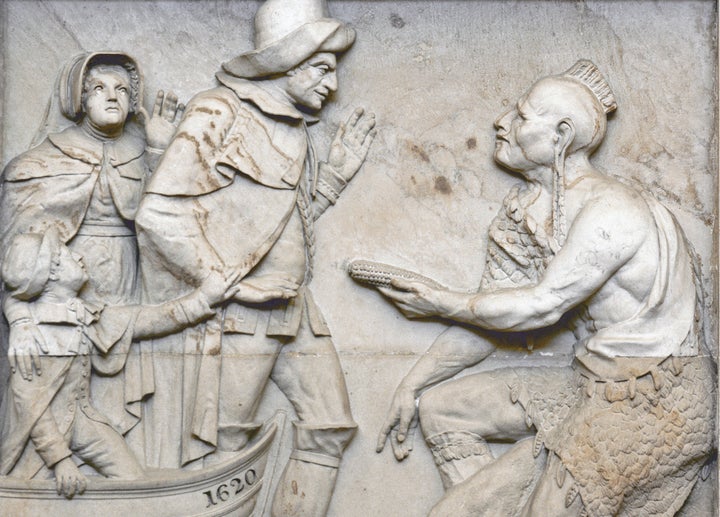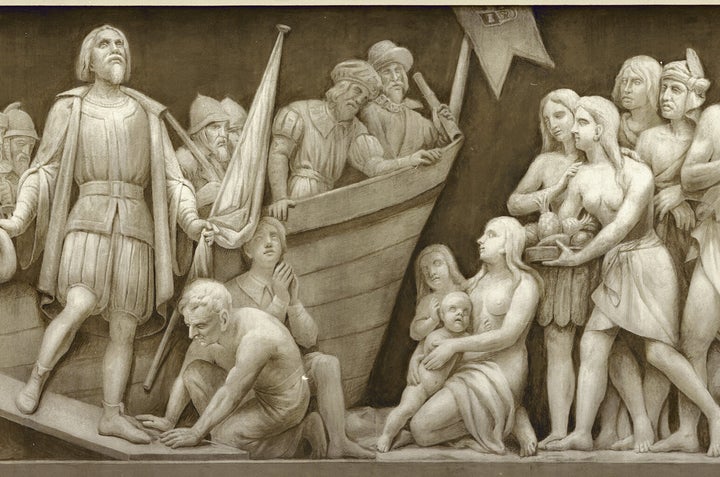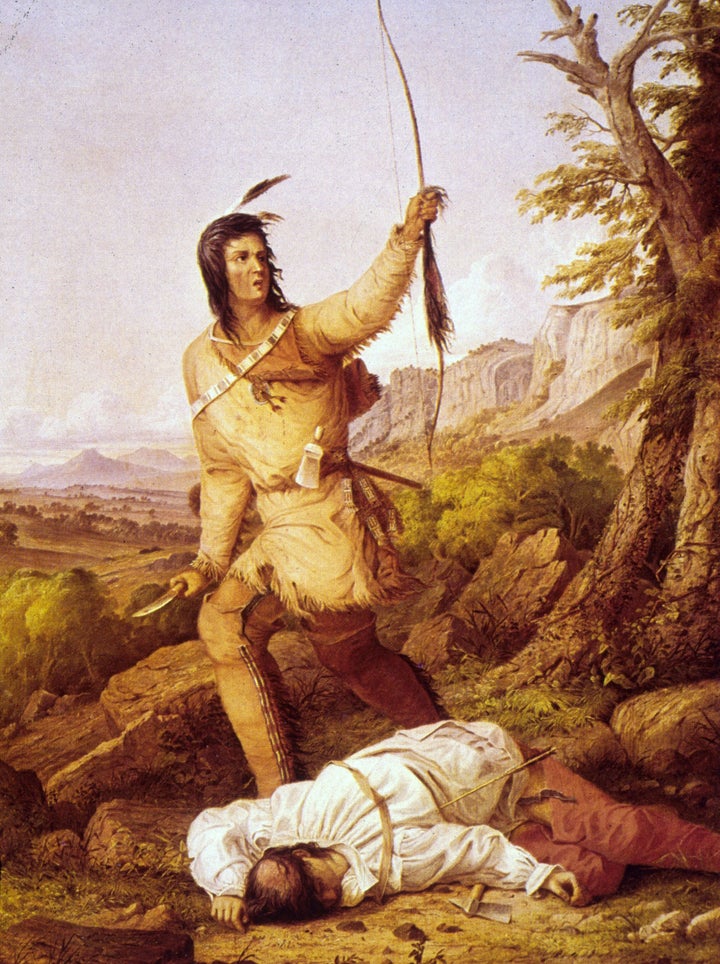
WASHINGTON ― It’s time to clean up the racist images of Native Americans all over the U.S. Capitol, House appropriators told the Architect of the Capitol in a new report.
“There are depictions of Native Americans throughout the Capitol complex that do not portray Native Americans as equals or Indian nations as independent sovereigns. Anecdotal evidence suggests that the way these works are described during Capitol tours is not always respectful,” reads a provision buried in a 51-page bill report accompanying the 2020 legislative branch spending bill, which the House Appropriations Committee passed last week.
Lawmakers made several requests of the Architect of the Capitol, which oversees the buildings and grounds of the Capitol. They want the office to consider displaying the flags of American Indian Nations with the flags of states draped around the Capitol; to talk to Native American historians to ensure that artwork “more accurately and respectfully” represents Native American history; and to consider displaying information somewhere in the Capitol “correcting the sometimes incomplete or incorrect depictions of Native Americans portrayed in historical artwork in the complex.”
The Architect of the Capitol is currently reformatting tours to address some of these concerns, the report notes, and is reframing an exhibit on the timeline of Congress and the Capitol. A spokeswoman for the Architect of the Capitol did not respond to a request for comment on what changes they plan to make.
Rep. Deb Haaland (D-N.M.) is behind this language in the bill report, according to committee spokesman Evan Hollander.
“We were glad to include it,” he said.
Haaland, one of two Native congresswomen and a co-chair of the Native American Caucus, said all Americans should feel welcome when visiting the Capitol.
“The depictions of Native Americans throughout the Capitol complex and the U.S. Capitol Rotunda reinforce inaccurate and oftentimes racist stereotypes about Native Americans,” she said in a statement. “So, I asked for a review of all the Native American artwork throughout to fully understand the extent that these images exist. After getting this report, I’ll work on ways to acknowledge how damaging imagery like this has been for Native communities in our country, and ways to make sure our community feels welcome in these buildings.”

One of Haaland’s requests is already getting results. She called for adding an American Indian Affairs expert to the staff of the Congressional Research Service, which produces research reports for lawmakers upon request. CRS posted the job opening on Thursday.
It’s hard to know which Capitol representations of Native Americans are troubling to Haaland; there are many to choose from. Some depict Native people as savages being led to civilization. Some are historically misleading. Others just show them being killed.
“Progress of Civilization,” an 1863 marble sculpture atop the Senate entrance to the Capitol, features figures “that represent the early days of America along with the diversity of human endeavor,” per the Architect of the Capitol’s description. America stands in the middle, signs of hope and fertility are on left, and on the opposite side, an “Indian chief, Indian mother and child, and Indian grave represent the early days of America.”
“Completing this side of the tympanum are sheaves of wheat, symbolic of fertility, and an anchor, symbolic of hope; these elements are in contrast with the grave at the opposite end of the tympanum,” reads the description.

“Landing of Columbus,” part of a frieze on display in the Capitol Rotunda created between 1855-1863, depicts Christopher Columbus disembarking from his ship and being greeted by Native Americans offering him fruit.
In reality, on his first day in the New World, Columbus “ordered six of the natives to be seized, writing in his journal that he believed they would be good servants,” per the History Channel’s website. “Throughout his years in the New World, Columbus enacted policies of forced labor in which natives were put to work for the sake of profits. Later, Columbus sent thousands of peaceful Taino ‘Indians’ from the island of Hispaniola to Spain to be sold. Many died en route.”

“Spanish Mission,” a mural installed in the ceiling on the first floor of the House wing between 1993-1994, features a Native man who converted to Christianity kneeling in prayer under the guidance of a monk, per the Architect of the Capitol description.
It seems peaceful and all, but it glosses over the fact that, for more than 100 years, white people forcibly removed Native children from their families and sent them away to live in Christian boarding schools to “civilize” them.

One painting of a Native man holding a white man’s scalp hung for more than a century in a House hearing room before being removed in 1987. “Death Whoop” is as historically inaccurate as it is offensive, then-Rep. Ben Nighthorse Campbell (D-Colo.) said at the time.
“I don’t see pictures of the internment of Japanese-Americans during World War II or the slavery of blacks,” said Campbell.
Here’s that painting, which is not on display in the Capitol anymore.

When it was on display, “Death Whoop” hung on the wall in a hearing room for the House Committee on Interior and Insular Affairs, which has since been renamed the Committee on Natural Resources.
One of this committee’s major priorities: legislation affecting Native Americans.
